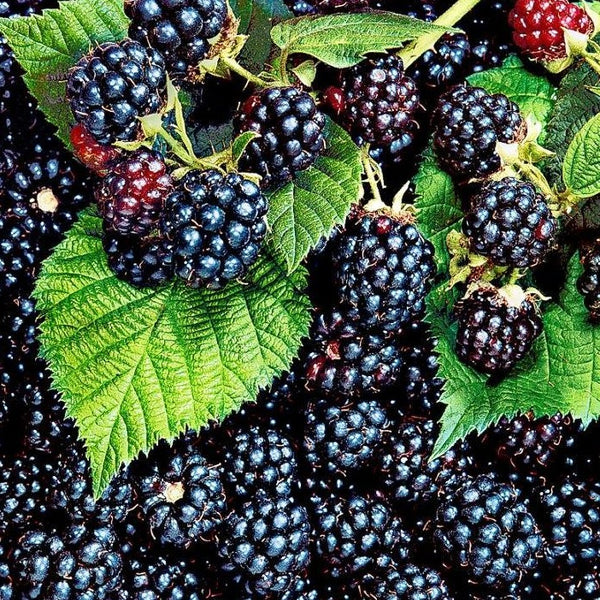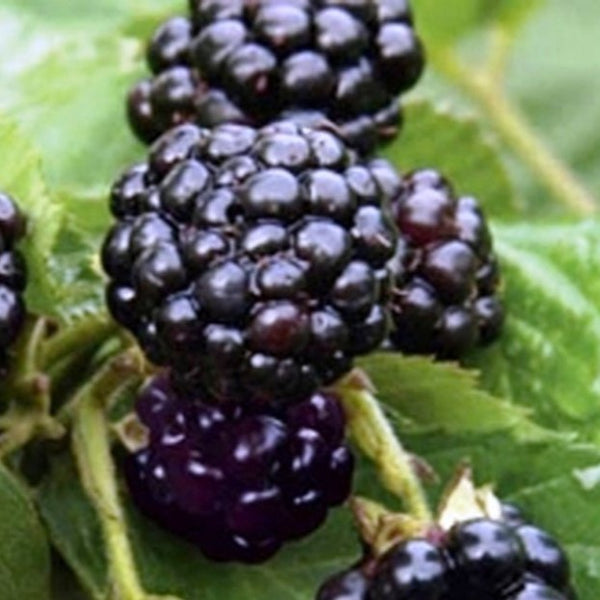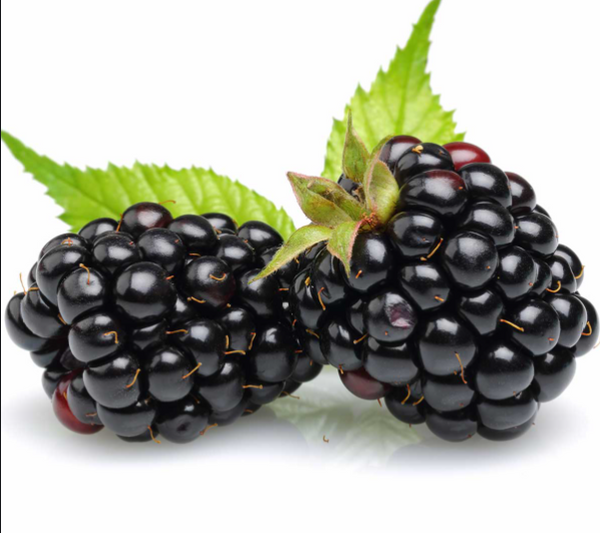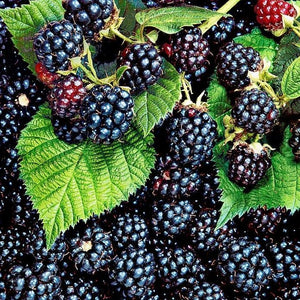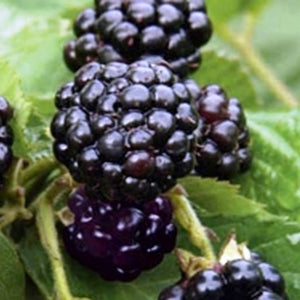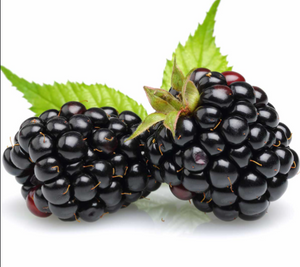Thornless Blackberry
Product Details
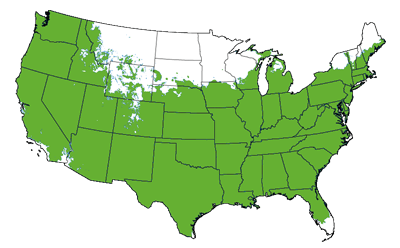 Growing Zones 5-9
Growing Zones 5-9
| Soil Type | Adaptable |
| Sunlight | Full, Partial |
| Drought Tolerance | Good |
| Mature Height | 3-4 Feet |
| Mature Width | 4-5 Feet |
| Shipping Restriction | AZ, CA |
Are you a berry lover? Do you often buy blackberries in the store but the taste just isn’t cutting it? Our solution is the Thornless Blackberry. It is easy to grow, low maintenance and provides an abundance of Blackberries for you and your family.
The Thornless Blackberry is one of the first berries of the season to produce. You could expect tons of huge, healthy berries from this small bush. Compared to other berry bushes, the maintenance is very low. No chemicals or upkeep needed. The Thornless Blackberry is drought tolerant and pest resistant!
You can expect the Thornless Blackberry bush to grow more upright than a traditional blackberry plant. They form huge clusters filled with berries.
Blackberries are full of vitamin C, vitamin K and magnesium. They are high in antioxidants. The naturally sweet flavor speaks for itself. The taste of those you buy in the store cannot compare to the ones you grow in your own backyard! The berries from the Thornless Blackberry can be used in desserts, jams, jellies or as a healthy snack.
What makes the Thornless Blackberry even more attractive? You don’t have to worry about being pricked or poked! Little children could pick their own berries without worrying about getting hurt. To guarantee a good harvest we recommend planting multiple bushes, a minimum of 3 for best results.
How To Care
When planting your Thornless Blackberry be sure to choose the right location and conditions for your new plant to thrive. Spring and Fall are ideal times to plant. However, if you avoid extreme temperatures you can plant your Blackberry plant almost any time of the year.
Blackberries thrive in full sun and well-drained, moist, slightly acidic, nutrient-rich soil. Water deeply when planting and 2-3 times weekly for 3 months while your Blackberry plant is establishing. During the growing and fruiting seasons, a blackberry will do best if the soil is kept moist. Keep up on your watering after harvest to encourage better cane production.
Adding a layer of 3 inches of mulch is highly recommended for blackberries. Mulching helps to maintain soil moisture, controls weeds, protects their shallow roots, and gives added protection during extreme temperatures. Fertilize in spring with a 10-20-10 from your local garden center.
Thornless Blackberries do well when trellised. Training your plant to a trellis allows sunlight to hit the entire plant and aids in air circulation, reducing the risk of disease. This variety generally stays on the smaller side so you may find trellising unnecessary.
If you have not trellised and your Blackberry is getting overgrown, prune new canes to 3 feet in summer to control growth. Prune any dead or crowded branches at the crown after harvesting fruit. Tip new (this years) canes to encourage lateral branching. To get a larger crop, trim lateral branches to 12 inches in early spring.
The best way to prevent disease and pests is by providing the appropriate care for your plants. Proper location choice, watering, and fertilization are the keys to your success. The biggest pests of blackberries are birds. You can put up bird netting to protect your crop. If positioned properly, this is an extremely effective deterrent.
The Thornless Blackberry is pest resistant so you aren't likely to have any serious issues. Fungal infections are a possibility with Blackberries. Generally, treating after infection isn't extremely effective, so if you have problems yearly, treat in early spring with fungicides to prevent infection. Be sure to clean up and throw away any debris left from pruning and avoid overhead watering to reduce reinfection.
Our Heritage Raspberry Bush is a great companion for a variety of berries right from your home.
For additional options, be sure to browse our Dwarf Tree and Fruit Trees collections.
When Does This Blackberry Bush Bare Fruit?
Expect large berries from this self pollinating bush in early summer.
Can I Cross Pollinate A Thornless Blackberry?
These shrubs are naturally self pollinators but can be pollinated to ensure higher yields. Rain, wind, and heat can all have an effect on a successful pollination.
When Is The Best Time To Transplant This Shrub?
Transplanting should be done while the plant is dormant in the late winter or early spring before the new grow season starts.
When planting your Natchez Thornless Blackberry be sure to choose the right location and conditions for your new plant to thrive. Spring and Fall are ideal times to plant. However, if you avoid extreme temperatures you can plant your Blackberry bush almost any time of the year.
Blackberries thrive in full sun and well-drained, moist, slightly acidic, nutrient-rich soil. Water deeply when planting and 2-3 times weekly for 3 months while your Blackberry plant is establishing. During the growing and fruiting seasons, a blackberry will do best if the soil is kept moist. Keep up on your watering after harvest to encourage better cane production. Adding a layer of 3 inches of mulch is highly recommended for blackberries. Mulching helps to maintain soil moisture, controls weeds, protects their shallow roots, and gives added protection during extreme temperatures. Fertilize in spring with a 10-20-10 from your local garden center. Thornless Blackberries do well when trellised. Training your plant to a trellis allows sunlight to hit the entire plant and aids in air circulation, reducing the risk of disease. This variety generally stays on the smaller side so you may find trellising unnecessary. If you have not trellised and your Blackberry is getting overgrown, prune new canes to 3 feet in summer to control growth. Prune any dead or crowded branches at the crown after harvesting fruit. Tip new (this years) canes to encourage lateral branching. To get a larger crop, trim lateral branches to 12 inches in early spring.
The best way to prevent disease and pests is by providing the appropriate care for your plants. Proper location choice, watering, and fertilization are the keys to your success. The biggest pests of blackberries are birds. You can put up bird netting to protect your crop. If positioned properly, this is an extremely effective deterrent. The Natchez Thornless Blackberry is pest resistant so you aren't likely to have any serious issues. Fungal infections are a possibility with Blackberries. Generally, treating after infection isn't extremely effective, so if you have problems yearly, treat in early spring with fungicides to prevent infection. Be sure to clean up and throw away any debris left from pruning and avoid overhead watering to reduce reinfection.
For additional options, be sure to browse our Dwarf Tree and Fruit Trees collections.


